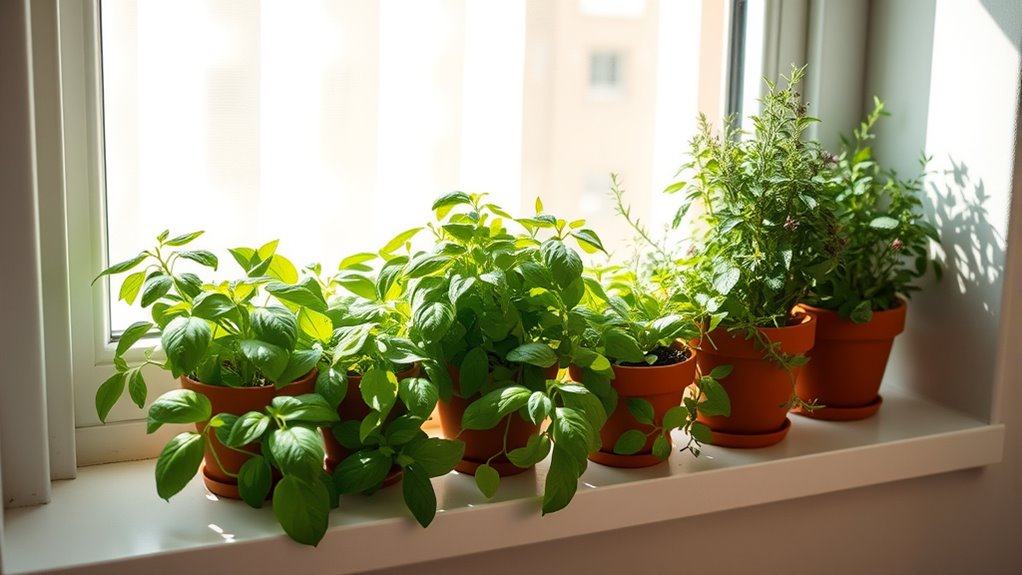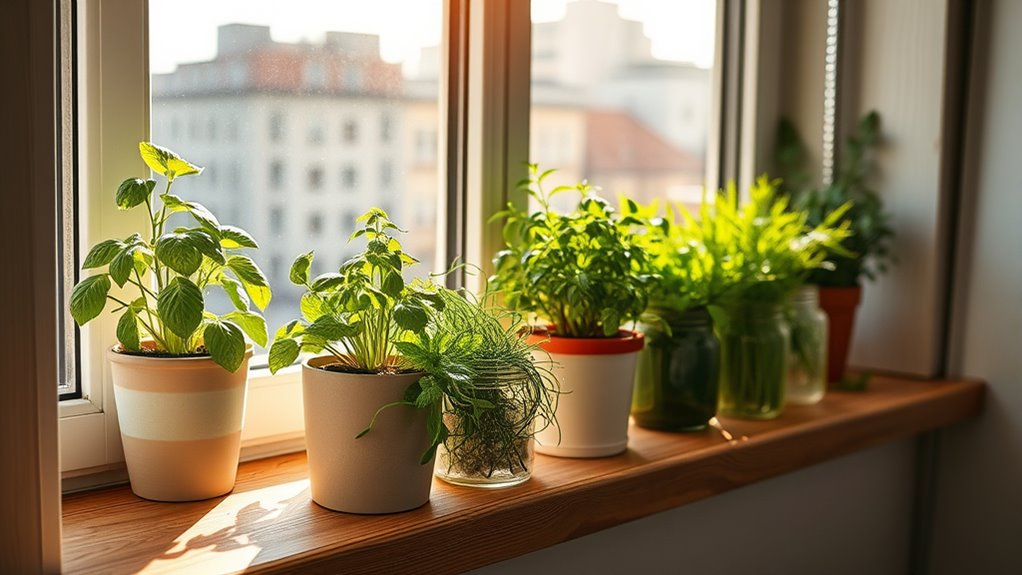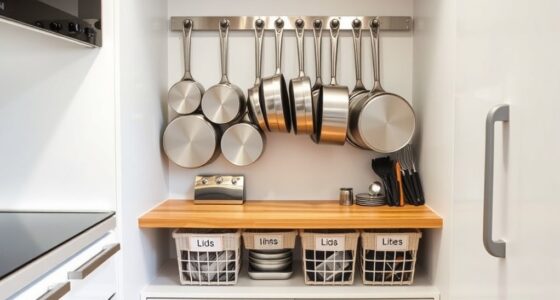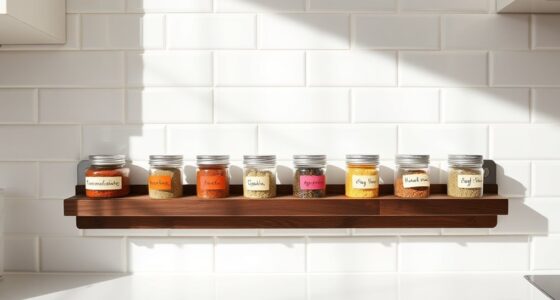Transforming your windowsill into a herb garden is a smart way to save space and bring fresh flavors right into your kitchen. Choose well-draining containers and high-quality soil, and place them where they get at least six hours of sunlight daily. Keep an eye out for pests and use natural remedies to stay ahead. With proper care and lighting, you’ll enjoy lush herbs year-round—discover more tips to keep your garden thriving.
Key Takeaways
- Choose south- or west-facing windowsills for ample natural sunlight, or supplement with grow lights if needed.
- Select well-draining containers and high-quality soil to promote healthy herb growth and prevent pests.
- Regularly inspect herbs for pests and address infestations promptly using natural remedies like neem oil or soap sprays.
- Keep the area clean and well-maintained to encourage healthy plants and reduce pest attraction.
- Incorporate popular herbs like basil, parsley, and mint for fresh flavors and a lively, green kitchen environment.

A window sill herb garden is a simple and rewarding way to bring fresh flavors into your kitchen. It allows you to grow herbs right where you cook, giving you easy access and the satisfaction of harvesting your own ingredients. To succeed, you need to consider indoor lighting because herbs thrive with sufficient sunlight. Most herbs require at least six hours of direct sunlight daily, so position your containers on a south- or west-facing windowsill if possible. If natural light is limited, supplement with grow lights to ensure your herbs stay healthy and vibrant. Proper lighting not only promotes lush growth but also helps prevent pests that often invade weak or stressed plants.
While tending to your window sill garden, pest management is vital. Pests like aphids, spider mites, or whiteflies can quickly infest your herbs, especially if the environment becomes too humid or if your plants are stressed due to inadequate lighting. Regularly inspect your herbs for signs of pests—distorted leaves, webbing, or sticky residue—and act promptly. Natural remedies work best for small infestations; you can spray a mixture of water and a few drops of dish soap or use neem oil. Keeping your herbs healthy and vigorous also makes them less attractive to pests. Avoid overwatering, as damp conditions invite mold and insects, and ensure good airflow around your plants.
Your choice of containers and soil can influence pest control and plant health. Use well-draining pots and high-quality potting soil to prevent root rot and discourage pests that thrive in soggy environments. Additionally, maintain cleanliness by removing dead leaves and fallen debris from your windowsill. This minimizes hiding spots for pests and reduces the chances of disease. As part of a healthy garden, understanding indoor lighting requirements is essential for optimal herb growth and pest prevention.
Incorporating herbs like basil, parsley, or mint on your windowsill not only adds flavor to your dishes but also creates a lively, green space in your kitchen. With proper indoor lighting, your herbs will flourish, providing fresh ingredients year-round. Keep an eye on pest activity and address issues early, so your garden remains productive and beautiful. Remember, a little effort goes a long way—consistent care, adequate lighting, and vigilant pest management will turn your window sill into a thriving green oasis. Soon, you’ll enjoy the convenience of snipping fresh herbs whenever you need them, all from the comfort of your own kitchen.
Frequently Asked Questions
What Are the Best Herbs for Low-Light Window Sills?
If your window sill has low-light herb lighting, you should choose herbs that thrive in such conditions. Basil and parsley need more light, so they might struggle, but mint, chives, and cilantro do well. When selecting containers, pick ones with good drainage and consider using darker containers to help retain moisture. Proper container choices and understanding herb lighting needs guarantee your herbs stay healthy and flavorful.
How Often Should I Water My Window Sill Herbs?
You should water your window sill herbs when the soil moisture feels dry about an inch below the surface. Typically, this means watering once or twice a week, but it depends on your home’s humidity and sunlight. Avoid overwatering, as it can cause root rot. Check the soil regularly, and adjust your watering frequency to keep the soil consistently moist but not soggy.
Can I Grow Herbs Indoors Year-Round?
Imagine you start growing basil indoors, and it flourishes all year long. Yes, you can grow herbs indoors year-round if you provide adequate indoor herb lighting and maintain proper watering. Consistent sunlight or grow lights support healthy growth. Remember herb harvesting tips like trimming regularly to promote new growth. With the right environment, your herbs stay fresh and productive, no matter the season, making your kitchen your perpetual herb garden.
What Are Common Pests for Window Sill Herbs?
When growing herbs on your window sill, pests like aphids, spider mites, and whiteflies can be common. To prevent these, practice pest prevention by keeping your herbs healthy and avoiding overwatering. If pests appear, try natural remedies like neem oil or insecticidal soap instead of chemicals. Regularly inspect your herbs and remove pests early to keep your window sill garden thriving and pest-free.
How Do I Prevent Herbs From Overcrowding?
Think of your herbs as a lively crowd that needs room to breathe. To prevent overcrowding, use pruning techniques to thin out dense foliage and encourage healthy growth. Companion planting can also help, as certain herbs naturally repel each other’s rivals, maintaining balance. Regularly check your herbs and trim as needed—this keeps them thriving and prevents them from becoming a tangled jungle on your window sill.
Conclusion
Just like a tiny seed can grow into a mighty tree, your small window sill can blossom into a lush herb garden. Remember, even the tiniest patch of greenery holds the power to bring freshness and life into your day. With patience and care, your space-saving garden becomes a reminder that greatness often starts small, and with a little nurturing, you can turn any corner into a thriving oasis. Your herbal journey is just beginning—nurture it with love.









